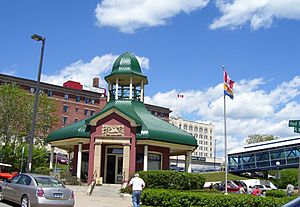Thunder Bay Tourist Pagoda facts for kids
Quick facts for kids Thunder Bay Tourist Pagoda |
|
|---|---|
 |
|
| Type | whimsical information kiosk |
| Location | Thunder Bay, Ontario, Canada |
| Built | 1909 |
| Architectural style(s) | Classical/Asian |
| Governing body | Parks Canada |
| Designated | 1986 |
The Thunder Bay Tourist Pagoda is a special building in Thunder Bay, Ontario, Canada. It was built a long time ago, in 1909. Its main job was to help visitors learn about the city of Port Arthur, Ontario. The Pagoda looks unique and was placed near the waterfront and train station. This was done to catch the eye of people arriving by train or boat. Today, it's recognized as a National Historic Site of Canada.
Contents
What is the Thunder Bay Pagoda?
The Thunder Bay Tourist Pagoda was built in 1909. It was one of the first places to give information to tourists. This building helped visitors explore the city of Port Arthur, Ontario. The Pagoda has a cool hexagonal (six-sided) shape. It was designed by an architect named H. Russell Halton. The Pagoda was used until 1986.
Why Was It Built?
The Pagoda was built for a few reasons. One reason was to attract visitors. It was placed where people arriving by train or water would easily see it. At that time, Port Arthur, Ontario was competing with a nearby city, Fort William. Both cities wanted to attract more people and businesses. The Pagoda helped Port Arthur stand out. Also, a new hotel, the Prince Arthur Hotel, was being built nearby. The Pagoda was meant to welcome guests to the area.
What Does It Look Like?
The Thunder Bay Tourist Pagoda has some interesting features. Above the main entrance, there is a stone panel. This panel shows a beaver and a maple branch. Both of these are important symbols of Canada. You can also see a small dragon's head on the roof, right over the entrance. Some people say this dragon's head is a symbol of good luck from Scandinavia.
The Colorful Roof
The roof of the Pagoda has been painted in fun ways over the years. In 1961, 1973, and 1985, the roof was painted with multi-colored polka dots! This made the building even more eye-catching.
A Historic Landmark
The Pagoda was used as a tourist information center until 1986. In that same year, it was given a special title. It became a National Historic Site of Canada. This means it's an important place in Canadian history. After being closed for a while, the building was reopened. Now it serves as a heritage building, reminding everyone of its past.

